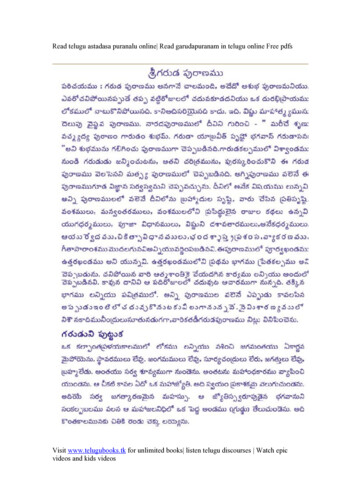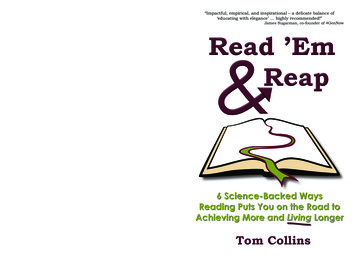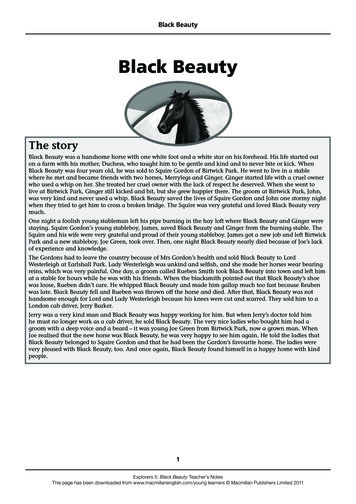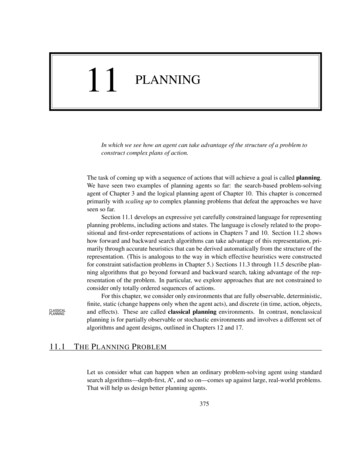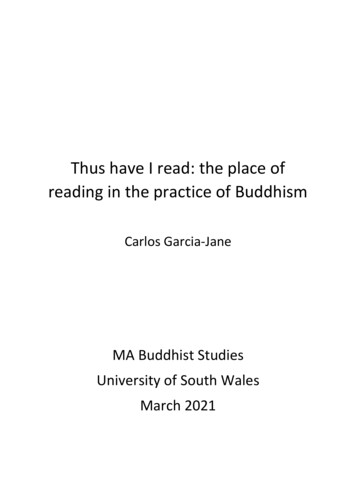
Transcription
Thus have I read: the place ofreading in the practice of BuddhismCarlos Garcia-JaneMA Buddhist StudiesUniversity of South WalesMarch 2021
Carlos Garcia-JaneStudent number: 17147948Module: RS4T01A 2019 v1: Dissertation Buddhist Studies (2019/20)AcknowledgementsI would like to thank Dr Nick Swann and Dr Warren Todd for all their help and assistance during thisMA. I would also like to thank my dissertation supervisor, Dr Sarah Shaw, for her comments duringthis MA and particularly for all her help, encouragement, and suggestions during the writing of thisdissertation.Finally, I would like to acknowledge Jarel A. Robinson-Brown for the conversations and especiallyRobert Thompson for all his support and companionship.
Table of ContentsAbstract . 5Abbreviations . 6Introduction . 13Chapter 1: Literature review, methodology, and definitions . 16Literature review. 16Methodology. 18Phenomenology . 18Reader-response criticism, aesthetics of reception, interpretative communities . 18Narratology . 19Reception theory. 19Sources . 20Content analysis . 21Defining reading . 21Reading attitudes . 21Reading levels . 21Reading purposes. 22Chapter 2: Reading in Buddhism. 24Theory . 24Placing Buddhist reading. 25Skilful means . 27Two-Truths doctrine . 27The end of reading: the ‘Simile of the Raft’ and the ‘Finger Pointing to the Moon’ . 27How Buddhists read . 28Readers’ intentions . 29For purification. 31For recollection and meditation . 31For knowledge and hermeneutics . 32Authenticity, canonicity, and authority . 33Chapter 3: Reading, reciting, orality . 36Early Buddhism . 38Chapter 4: Multiple perspectives of reading in Buddhist traditions. 40Theravāda Buddhism . 40Mahāyāna Buddhism . 40Tantra . 421
Tibetan Buddhism . 42Reading-transmission. 43Terma . 44Mongolian Buddhism . 44Chinese Buddhism. 44Japanese Buddhism. 45Vietnamese Buddhism . 45Ch’an/Zen . 45Dōgen . 47Pure Land Buddhism . 47Nichiren Buddhism . 47Chapter 5: Buddhist revivals and modern contexts. 49Buddhist revivals . 49Buddhism in the West . 50You cannot learn Buddhism from a book . 52Conversion and affiliation . 53Reception and responses . 55Readers and text . 55Religious reading . 56Reading literature . 59Religious experiences. 60Modernity, secularism, globalization . 60Bookshop Buddhists. 64Reading responses . 67Conclusions . 70Appendix A: Merit, cults, and pedagogies . 74Merit . 74Relics and the cult of the book . 75Pedagogical reading . 77Scholarly and scholastic reading . 80Translating and editing as reading . 80Reading biographies. 80Appendix B: Merit, copying, and preserving Dharma-texts . 83Copying . 83Manuscripts . 83Printing . 842
Digital . 86Inscriptions . 86Dāna . 87Libraries, storage, and reading spaces . 87Revolving libraries . 88Reading locations . 89Destruction of texts . 89Disappearance of reading . 90Appendix C: Reading typologies. 91Public readings . 91Ritual readings . 92Reading for protection and magic . 92Cultic reading . 93Reading in part . 94Reading titles . 94Reading formulae . 95Reading illustrated manuscripts . 95Pictorial reading . 96Scripture not to be read . 96Relic deposits . 96Burials and entombment . 96Implausible reading. 97Reading while sleeping and dreaming . 97Impossible reading . 97Ingesting as reading . 97Mechanically activated reading . 98Prayer wheels. 98Prayer flags. 98Circumambulation and walking . 98Turning-reading. 99Reading to the other . 99The dying, the dead, funeral readings, and ghosts . 99Animals. 100Criminals . 100Gods . 100Reading by the other . 1003
Appendix D: Data analysis. 102Appendix E: Corpus . 104Notes . 105Bibliography . 1194
AbstractPurpose: Reading plays a central role in the transmission, reception, and practice of Buddhism. Thisdissertation seeks to address a perceived gap in Buddhist studies by suggesting that readingconstitutes a valid strategy of practice and a useful phenomenon to analyse Buddhist roles andidentities.Aims and objectives: This study aims to explore several occurrences of reading in Buddhism. It seeksto outline a history of reading in Buddhism and to suggest some theoretical foundations which justifythe practice of reading. It also attempts to describe the reception of Dharma-texts through reading indifferent historical contexts, including the contemporary world.Methods: The main body of this dissertation comprises the compilation of a corpus of references toreading found in primary and secondary literature. These references have been contextualised byhistorical research and justified by an exploration of several Buddhist doctrines and theories relevantto reading. This dissertation adopts a phenomenological stance thus allowing religious agents thecapacity to provide meaning to their own actions. Interpretative strategies have been informed byreader-response criticism, aesthetics of reception, narratology, and reception theory. Content analysisof Facebook posts and Goodreads reviews has been employed to analyse recent individual responsesto Buddhist literature.Results: A corpus of over 14,500 entries with references to reading in Buddhism has been compiledusing primary and secondary literature. An outline of the history of reading in Buddhism has beensuggested. A theoretical basis for reading in Buddhism has been proposed. The attitudes of differentBuddhist traditions and schools towards reading, including the reception of Dharma-texts incontemporary contexts, has been described. A ranking of the top ten recommended Dharma-textshas been compiled based on a list of 1,217 recommendations found on Facebook groups postsbetween March and September 2020. 500 of the most recent book reviews of those recommendedDharma-texts on Goodreads have been analysed for content.Conclusions: No similar study could be traced in the literature. This dissertation concludes that readingconstitutes a central practice in Buddhism and one of its main means of transmission. Readingsupports Dharma practice, provides moral exemplars, develops faith, purification, and meditation.Buddhism advocates reading slowly and repeatedly, and encourages embodying the teaching bymeans of familiarity and memorization of Dharma-texts. This study also shows that reviews on socialmedia platforms can be used to understand the reception of Dharma-texts by contemporaryaudiences, hence enriching the knowledge of the practices of Bookshop Buddhists and Buddhistsympathizers and contributing to the debate about religious identity and affiliation. This analysissuggests that most readers of Dharma-texts seek spiritual fulfilment, religious knowledge, inspiration,and practical advice from a demystified, non-dogmatic, and relatable perspective.5
Abbreviations[NB: This includes references found in this dissertation and in ‘Appendix E: Corpus’]AAṅguttara Nikāya: Bodhi, B. (ed., trans.) (2012) The Numerical Discourses of theBuddha: a translation of the Aṅguttara Nikāya. Somerville: Wisdom Publications.Teachings of the hāyāna-Sūtra (Sūtra of Boundless Life andWisdom): Pearcy, A. (trans.) (2007). Sūtra of Boundless Life and Wisdom [Updatededition] [Online]. [S.l.]: Lotsawa House. Available a/sutra-boundless-life(Accessed: 09 November 2020).AaśAdhyardhaśatikā Prajñāpāramitā: Conze, E. (trans.) (1965) ‘The AdhyardhaśatikāPrajñāpāramitā’, in Nakano, G. (ed.) Studies of esoteric Buddhism and Tantrism incommemoration of the 1,150th anniversary of the founding of Koyasan. Koyasan:Koyasan University, pp. 101-115.AKBAbhidharmakośa-Bhāṣya: La Vallée Poussin, L. d.; Lodrö Sangpo (trans.) (2012)Abhidharmakośa-Bhāṣya of Vasubandhu: the treasury of the Abhidharma and its(auto)commentary. Delhi: Motilal Banarsidass trendra-rāja-mahāyāna-Sūtra (The King of GloriousSūtras called the Exalted Sublime Golden Light): Dawa, L. (trans.) (2007) The King ofGlorious Sūtras called the Exalted Sublime Golden Light: a Mahāyāna Sūtra [Online].Portland: Foundation for the Preservation of the Mahāyāna Tradition. Available F p 2348.html (Accessed: 09 November 2020).AṣṭaAṣṭasāhasrikā Prajñāpāramitā Sūtra: Conze, E. (trans.) (1973) The Perfection ofWisdom in Eight Thousand lines and its verse summary. San Francisco: City Lights.Wheel series, 1.AvaAvataṃsaka Sūtra: Cleary, T. (trans.) (1993) The Flower Ornament Scripture: atranslation of the Avataṃsaka Sūtra. London: Shambhala.A-yuRongixi, L. (trans.) (1993) The biographical scripture of King Aśoka: translated from theChinese of Saṃghapāla (Taishō, Volume 50, Number 2043). Berkeley: Numata Centerfor Buddhist Translation and Research. BDK English Tripiṭaka 76-II.BABlue Annals: Roerich, G. N. (trans.) (2016) The Blue Annals [Third revised edition]Delhi: Motilal Banarsidass.BaizhangBaizhang Zen Monastic Regulations: Ichimura, S. (trans.) (2006) The Baizhang Zenmonastic regulations (Taishō volume 48, Number 2025) [Online]. Berkeley: NumataCenter for Buddhist Translation and Research. BDK English Tripiṭaka series. Availableat: nastic-regulations/(Accessed: 09 November 2020).6
BcaBodhicaryāvatāra: Crosby, K. and Skilton, A. (trans.) (1995) The Bodhicaryāvatāra [by]Śāntideva. Oxford: Oxford University Press. Oxford world’s classics.BppBodhipathapradīpa: Gyatso, T.; McClen Novick, R., Jinpa, T., and Ribush, N. (eds.)(2002) Illuminating the path to enlightenment: a commentary on Atisha DipamkaraShrijnana’s A Lamp for the Path to Enlightenent and Lama Je Tsong Khapa’s Lines ofExperience. Translated by Geshe Thupten Jinpa. Long Beach: Thubten Dhargye Ling.ButönButön’s History of Buddhism: Stein, L. and Zangpo, N. (trans.) (2013) Butön’s Historyof Buddhism in India and its spread to Tibet: A Treasury of Priceless Scripture; ButönRinchen Drup. London: Snow Lion Publications. The Tsadra Foundation series.CBChanlin baoxun/Chanmen baoxun Precious Lessons from the Chan Schools: Cleary,T. (trans.) (2005a) ‘Zen Lessons’, in Cleary, T. Classics of Buddhism and Zen: thecollected translations of Thomas Cleary. Volume One. Boston: ShambhalaPublications, pp. 3-124.CśkCatuḥśatakakārikā: Sonam, R. (2008) Āryadeva’s Four Hundred Stanzas on the MiddleWay; with commentary by Gyel-tsap. Ithaca: Snow Lion Publications. Textual studiesand Translations in Indo-Tibetan Buddhism.CspCaturaśīti-siddha-pravṛtti: Robinson, J. B. (trans.) (1979) The Buddha’s lions: the livesof the eighty-four siddhas: Caturaśīti-siddha-pravṛtti by Abhayadatta, translated intoTibetan as Grub thob brgyad cu rtsa bzhi’i lo rgyus by sMon-grub Shes-rab. Berkeley:Dharma Publishing. Tibetan translation series, 10.DDīgha Nikāya: Walshe, M. (trans.) (2012) The Long Discourses of the Buddha: atranslation of the Dīgha Nikāya. Somerville: Wisdom Publications. Teachings of theBuddha.Dā 1Divyāvadāna. Part 1: Rotman, A. (trans.) (2008) Divine stories: Divyavādana. Part 1.Boston: Wisdom Publication. Classics of Indian Buddhism.Dā 2Divyāvadāna. Part 2: Rotman, A. (trans.) (2017) Divine stories: Divyavādana. Part 2.Boston: Wisdom Publication. Classics of Indian Buddhism.DhpDhammapada: Roebuck, V. J. (ed., trans.) (2010) The Dhammapada. London: PenguinBooks. Penguin Classics.DīpDīpavaṃsa: Oldenberg, H. (trans.) (1879) The Dīpavaṃsa: an ancient Buddhisthistorical record. London: Williams and Norgate.Fa-chüFa-chü p’i-yü ching: Willemen, C. (1999) The scriptural text: verses of the doctrine, withparables: translated from the Chinese of Fa-li and Fa-chü (Taishō Volume 4, Number211). Berkeley: Numata Center for Buddhist Translation and Research. BDK EnglishTripiṭaka 10-II.FanwangFanwang jing: Muller, A. C. and Tanaka, K. K. (trans.) (2017) The Brahmā’s Net Sūtra(Taishō Volume 24, Number 1484). Moraga: BDK America. BDK English Tripiṭaka series.Hasshū-KHasshū-Kōyō: Pruden, L. M. (trans.) (1995) The essentials of the Vinaya tradition byGyōnen: translated from the Japanese (Taishō, Volume 74, Number 2348). Berkeley:Numata Center for Buddhist Translation and Research. BDK English Tripiṭaka 97-I.7
HekiganrokuHekiganroku The Blue Cliff Record: Sekida, K. (trans.); Grimstone, A. V. (ed.) (2005)Two Zen classics: The Gateless Gate and the Blue Cliff Records. London: ShambhalaPublications.HvtHevajra Tantra: Snellgrove, D. L. (trans.) (1959) The Hevajra Tantra: a critical study.Part I: Introduction and translation. London: Oxford University Press.ItItivuttaka: Ireland, J. D. (trans.) (1997) The Udāna: inspired utterances of the Buddha& The Itivuttaka: the Buddha’s sayings. Kandy: Buddhist Publication Society.JātJātaka: Cowell, E. B. (ed.) (2005-2016) The Jātaka or stories of the Buddha’s formerlives. Bristol: Pali Text Society.JolJewel Ornament of Liberation: Guenther, H. V. (trans.) The Jewel Ornament ofLiberation by sGam.po.pa. Berkeley: Shambhala Publications. The clear light series.KaimokushōKaimokushō: Murano, S. (trans.) (2000) Kaimokushō or liberation from blindness byNichiren: translated from the Japanese (Taishō Volume 84, Number 2689). Berkeley:Numata Center for Translation and Research. BDK English Tripiṭaka 104-IV.Kakuban texts Todaro, D. A. (2004) Shingon texts: The Mitsugonin confession; the illuminating secretcommentary on the five chakras and the nine syllables by Kakuban (Taishō Volume 79,Number 2527, 2514). Berkeley: Numata Center for Buddhist Translation and Research.BDK English Tripiṭaka 98-VI, VII.Kūkai textsGiebel, R. W. (2004) Shingon texts: On the difference between exoteric and esotericteachings; the meaning of becoming a Buddha in this very body; the meanings ofsound, sign, and reality; the meaning of the word Hūṃ; the precious key to the secrettreasure, by Kūkai: translated from the Japanese (Taishō Volume 77, Numbers 2427,2429, 2430, 2426). Berkeley: Numata Center for Buddhist Translation and Research.BDK English Tripiṭaka 98-I, II, III, IV, V.Kyōgyōshinshō Kyōgyōshinshō: Inagaki, H. (trans.) (2003) Kyōgyōshinshō: on teaching, practice, faith,and enlightenment by Shinran: translated from the Japanese (Taishō Volume 83,Number 2646). Berkeley: Numata Center for Buddhist Translation and Research. BDKEnglish Tripiṭaka 105-I.Lam Rim 1Lam rim chen mo: Lamrim Chenmo Translation Committee (trans.); Newland, G. (ed.)(2000) The great treatise on the stages of the path to Enlightenment by Tsong-kha-pa.Volume one. Ithaca. Snow Lion Publications.Lam Rim 2Lam rim chen mo: Lamrim Chenmo Translation Committee (trans.); Newland, G. (ed.)(2004) The great treatise on the stages of the path to Enlightenment by Tsong-kha-pa.Volume two. Ithaca. Snow Lion Publications.Lam Rim 3Lam rim chen mo: Lamrim Chenmo Translation Committee (trans.); Newland, G. (ed.)(2002) The great treatise on the stages of the path to Enlightenment by Tsong-kha-pa.Volume three. Ithaca. Snow Lion Publications.LinjiLinji Lu Rinzai Roku: The recorded saying of Linji: Cleary, J. C. (trans.) (1999) Therecorded sayings of Linji, in Sengaku, M. (ed.) Three Chan classics: the recorded sayingsof Linji; Wumen’s Gate; The Faith-mind Maxim (Taishō Volumes 47 and 48 Numbers8
1985, 2005, 2010). Berkeley: Numata Center for Buddhist Translation and Research.BDK English Tripiṭaka 74-I, II, III.MMajjhima Nikāya: Ñāṇamoli, B. and Bodhi, B. (eds., trans.) (2001) The Middle LengthDiscourses of the Buddha: a translation of the Majjhima Nikāya [Revised]. Oxford: PaliText Society. Teachings of the Buddha; Pali Text Society Translation series, 49.MātaṅgaMātaṅga Sūtra: Giebel, R. W. (trans.) (2015) ‘The Mātaṅga Sūtra (Taishō Volume 21,Number 1300)’ in Mayeda, S. (ed.) Esoteric texts. Moraga: BDK America. BDK EnglishTripiṭaka series.MavMadhyāntavibhaṅga: Dharmachakra Translation Committee (trans.) (2006) Middlebeyond extremes: Maitreya’s Madhyāntavibhaṅga with commentaries by KhenpoShenga and Ju Mipham. Ithaca: Snow Lion Publications.MhvMahāvaṃsa: Geiger, W. (trans.) (1912) The Mahāvaṃsa, or the great chronicle ofCeylon. London: Pali Text Society.MilnMilindapañha: Horner, I. B. (trans.) (1963-1964) Milinda’s questions. Bristol: Pali TextSociety. Sacred books of the Buddhists, 23.MsMahāyānasaṃgraha: Brunnhölzl, K. (trans.) (2018) A compendium of the Mahāyāna:Asaṅga’s Mahāyānasaṃgraha and its Indian and Tibetan commentaries. Boulder:Snow Lion. The Tsadra Foundation series.MumonkanMumonkan The Gateless Gate: Sekida, K. (trans.); Grimstone, A. V. (ed.) (2005) TwoZen classics: The Gateless Gate and the Blue Cliff Records. London: ShambhalaPublications.Nirvana-SMahāparinirvāṇa Sūtra: Blum, M. K. (trans.) (2013) The Nirvana Sūtra(Mahāparinirvāṇa-Sūtra). Volume 1 (Taishō Volume 12, Number 374): translated fromthe Chinese. Moraga: BDK America. BDK English Tripiṭaka series.PaṭisPaṭisambhidāmagga: Ñāṇamoli, B. (trans.) (2014) The Path of Discrimination(Paṭisambhidāmagga) [Second edition]. Oxford: Pali Text Society. Pali Text Societytranslation series, 43.PlatPlatform Sūtra: McRae, J. R. (trans.) (2000) The Platform Sūtra of the Sixth Patriarch:translated from the Chinese of Zongbao (Taishō Volume 48, Number 2008). Berkeley:Numata Center for Buddhist Translation and Research. BDK English Tripi
and Translations in Indo-Tibetan Buddhism. Csp Caturaśīti-siddha-pravṛtti: Robinson, J. B. (trans.) (1979) The Buddha’s lions: the lies of the eighty-four siddhas: Caturaśīti-siddha-pravṛtti by Abhayadatta, translated into Tibetan as Grub thob brg Çad cu rtsa bzhi’i lo






